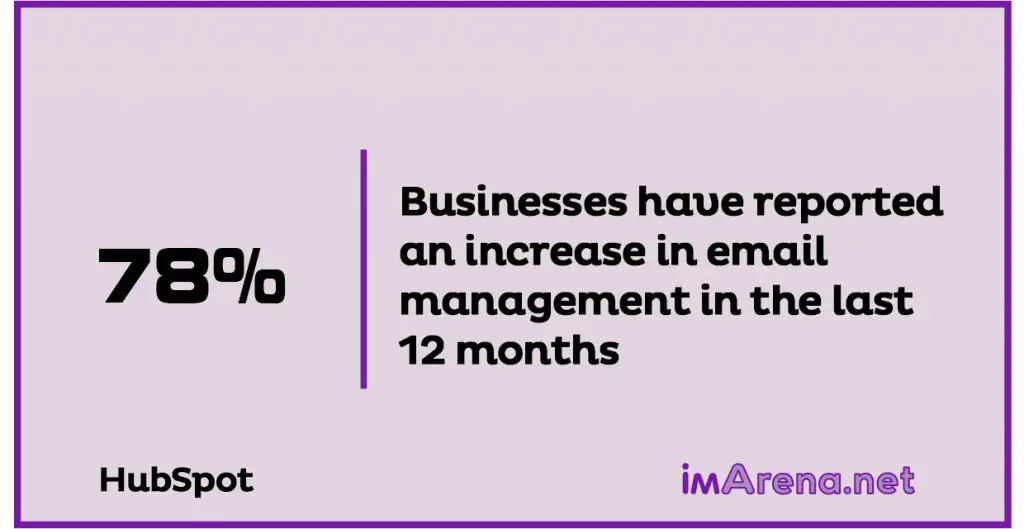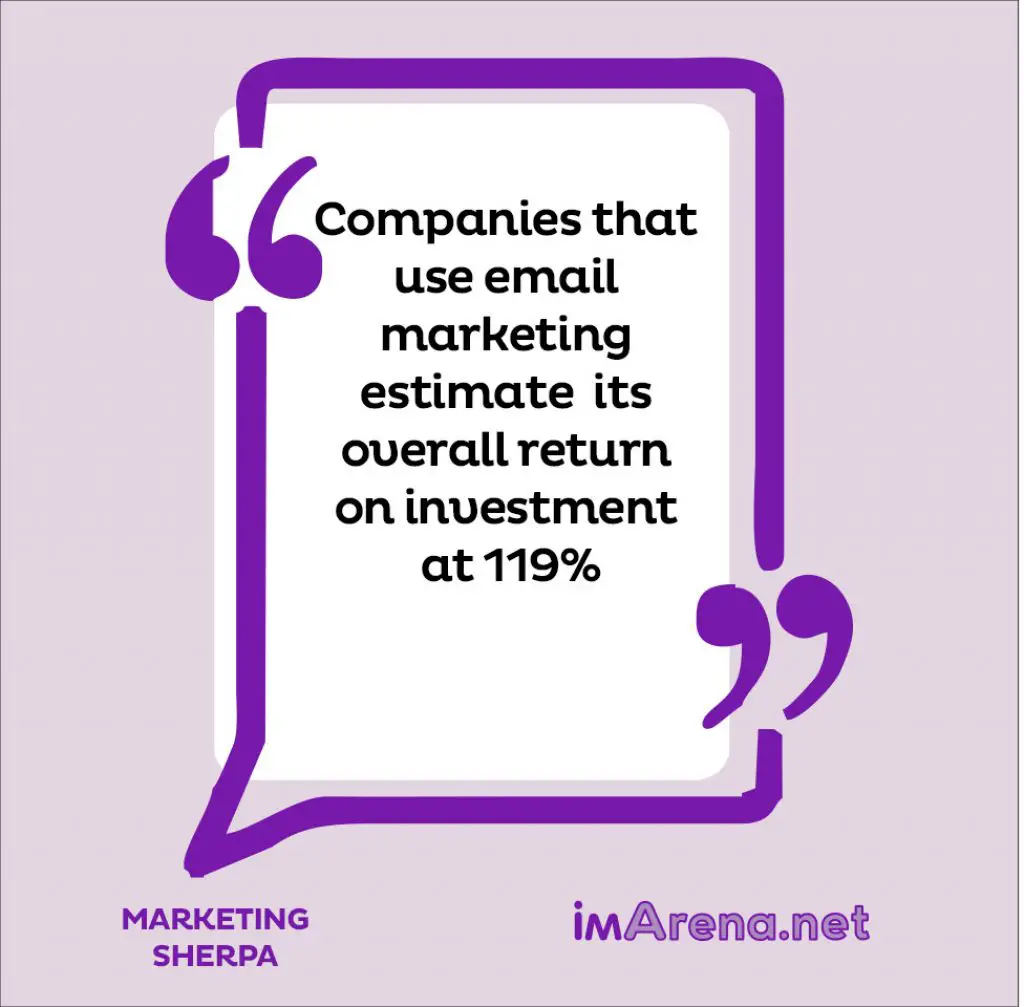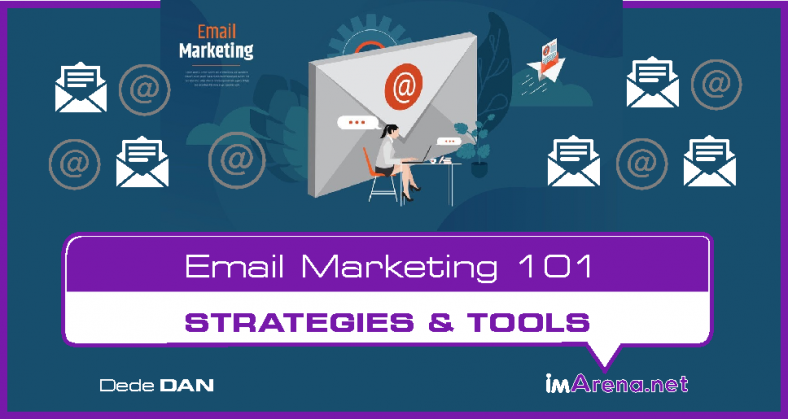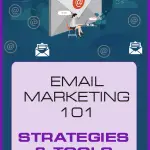
I hope you enjoy reading this blog post.
If you want my team to just do your marketing for you, click here.
A good email marketing strategy is crucial to the success of any email marketing campaign. Otherwise, you would end up not getting the desired results. And developing a good strategy not only depends on how knowledgeable you are about your business but also depends on the tools you use.
This is why in this post, we will enlighten you on everything you need to know to succeed with email marketing as well as some email marketing examples that will benefit your email marketing goals.
Ready? Let’s dive in!
What Is Email Marketing?
Email marketing is a channel through which companies send marketing messages to subscribers who have signed up for their email marketing campaigns.
Email marketing can be used to achieve a lot of purposes. It can be used as a marketing tool to promote products and services. It can also be used to provide information about a business and how they operate in order to foster business to client relationship.
Email marketing has advanced rapidly over the past few years. And with the right email marketing strategy, you can achieve a lot for your business. With the modern email marketing tools, you can personalize emails with people’s names, add social sharing buttons, create highly segmented audiences, automate actions and monitor performance with advanced analytical tools.
It still remains one of the most cost-effective, conversion-rich forms of digital marketing. Social media, SEO, and PPC are all great tools for marketers but don’t be mistaken, email marketing is still powerful, low-budget, and can get your business great results.
Importance Of Email Marketing
Email marketing can be a powerful way to connect with leads and nurture them, and then convert them into customers.
It is essential for many marketing strategies, including account-based, content, and inbound marketing.
You can send personalized messages to your customers and prospects that will help them build a relationship with your brand. This is a great way for customers to be engaged and get their attention.

HubSpot Research, Global Survey, Nov–Dec 2019, 78% have reported an increase in email management in the last 12 months, according to HubSpot Research, Global Survey, November–Dec 2019. As consumers increasingly prefer to connect with brands via email, the ROI of email marketing is rising.
According to this survey, promotional emails are the most popular email type that marketers would prefer to invest in. Consumers are always connected to their mobile phones and can access their email via their mobile devices. Email is one way to make sure your customers don’t miss any updates from you.
Types Of Emails Marketing
There are 3 major types of email marketing, and they are Informational emails, Promotional Emails, and Transactional emails.
Within these 3 major types, we will be looking at the sub-types under each of them.
#1 – Informational emails:
Informational emails are emails that you send to people to inform them about your latest content, blog, or general business information.
Such kinds of informational emails include –
- Product Update Email
To keep customers and fans informed about the latest features, many companies send product digests every week or monthly. No matter how much your customer loves you, they still need to learn new features and why investing in a product is worthwhile.
Instead of bombarding your contacts with emails about every product update, send a roundup of updates and products to them periodically. Include a clear headline and a short description along with an image to highlight the product or feature in each update. To make it easier for recipients to find out more, it’s worth creating a link to each feature’s own page.
Keep in mind that the essence of a Product Update Email in this sense is to inform your leads about an update to a product.
-
Newsletters
If you have a blog or Video Channel for your business, where you publish articles and/or videos, you can send a newsletter to your subscribers about any new blog or video content. That way, they can go check it out.
Newsletters are more informational than promotional, and if your content is good and addresses your subscriber pain points, they will totally value your newsletter.
-
Internal Updates
Internal updates are mostly for companies with a good number of employees.
Employees are an important audience for your business. Most large and medium companies send out newsletters or updates to employees in order to keep them informed about any new company news, change in admin, or product developments.
#2 – Promotional emails

An email that promotes your products or services is a promotional email. Promotional email is one of the most common types of email marketing available. In fact, it is the major reason most businesses invest in email marketing. Therefore, promotional emails should form a huge part of your email marketing strategy. Emails with promotional content are sent to inform the email list about exclusive offers, limited-time deals, and with an intent to sell.
A promotional email’s goals are to speed up the buying process, create new customers or repeat customers, and encourage contacts to take action. Conversions can be purchases but also downloads, scheduling calls, registration for events, and other actions.
When creating promotional emails, the most important thing to remember is the relationship with the recipient. Your posts should be positive and open about your brand, products, values, and history. It should not be just about the price. Be careful about the frequency of your promotional emails. Too many can be detrimental, reduce the user’s attention span, and become a nuisance. This could even make you lose subscribers and many might decide to opt-out of your mail list.
Remember these things when you send out promotional emails – Less is better, and avoid problems with reputation and deliverability.
Here are some kinds of promotional emails:
-
Sales
Sending an email with the intention to sell is one way to run a promotional email. In this email, whatever it will take to convince the recipient to purchase the product immediately becomes the main content of the email. Also, most of the link in the email is direct to the sales page of the product or service.
-
Exclusive Promotion.
This involves sending out emails that offer certain products as exclusive to certain categories of people.
The idea is that human psychology loves the idea of knowing they can get access to something that is exclusive to only a small group of people, and naturally, they would love to be a part of that small group.
This way, they can boast to their circle that they can’t find that product elsewhere.
-
Limited Time Offers
Emails with limited-time offers are a kind of promotional email too.
You can send emails with limited-time offers to also create a sense of urgency. This will prompt subscribers interested in that offer to purchase as fast as possible. The industry term for this strategy is FOMO (fear of missing out).
-
Freebies
People love freebies. And you can take advantage of it and offer some freebies to your visitors to attract them. Adding freebies as an incentive to get your leads to buy is a great way to promote an offer. To increase its effectiveness, this technique should be used in conjunction with urgency leverage. An example of freebies include – Free Trials, Free Delivery, Buy One to Get One Free, etc.
#3 – Transactional emails
Transactional emails are emails that are triggered when a specific action is taken that is related to a transaction.
Transaction emails are mostly automated and they include – confirmation emails when signing up for a newsletter, password change request emails, invoice due emails, payment notification emails, etc.
Email Marketing Campaign Strategy
Email marketing campaign is a core part of email marketing. This is why we are going to look into what an email marketing campaign really is, and also look into various terms and metrics used in email marketing campaigns as well as the phases of email marketing campaigns.
What Is An Email Marketing Campaign?
An email marketing campaign is a series of email messages that are sent to a recipient over a given period of time.
These series of emails are somehow all related to one purpose and are prepared with a specific goal in mind – to get the recipient to take a particular action.
This action could be to attend an upcoming webinar, download a whitepaper or purchase a product. It is worthy to note that email marketing campaigns are intentional and well planned out. To achieve your campaign goals, each email must have a clear subject line and focused content.
As with all digital content, the subject line must be informative but also catchy. It should encourage people to click without over-promising or under-promising what’s inside. Your recipients will not be happy with subject lines that do not accurately reflect what is inside. And that can affect your brand negatively.
Focused content is content that is both relevant to the overall concept of your email campaign and to your entire audience. Marketers may use dynamic content in many campaigns to reach different segments of their audience.
Good email marketing campaigns usually include one CTA, and CTA buttons must be bold and clear without taking away from the message.
Email Marketing Campaign Metrics at A Glance
To measure the success of an email campaign, there are many different metrics. These metrics include:
- Open Rate: This is the number of people who opened your email relative to the total number sent.
- Click-Through-Rate (CTR): This is the number of people who clicked through to your email and not those who opened it.
- Conversion Rate: The percentage who purchased a product or service after clicking through to your email.
- Bounce rate: The percentage of people who click on your email and do not interact with it.
- Subscribe rate: This is the percentage of subscribers that have increased/decreased over a time period to your email marketing lists
- Unsubscribe rate: This is the percentage of subscribers who unsubscribe to a campaign or for a certain period.
Phases of an Email Campaign
You can organize your campaign by following the different phases of an email marketing campaign.
The phases of an email marketing campaign involve sending messages that are relevant to the lead depending on the stage he is in the marketing cycle. To properly carry out an email marketing campaign, you need to track every lead’s move and send them emails that will benefit them the most at the stage they are in.
The Email Marketing Cycle has four main phases:
PHASE I: On-boarding
After a contact has subscribed to your email list, onboarding is the first step. This stage is where you only know that your lead is interested in your offers or business. Although the reason behind their interest is not yet known, they offer you an opportunity to demonstrate what you have to convince them to move on.
This stage is for welcoming the contact and learning about them. Who are they? Where are they from? What are their interests? So on. Marketers can send personalized, valuable messages by capturing this information as soon as possible.
PHASE II: Nurture
Once you have enough data about your contacts, it is time to introduce your brand and products to them without sounding too promotional, explain to the contact what your brand stands for, what it means to them, and how you differ from others. Invite them to join your social media networks.
Simply put, you want to make your contact feel safe and secure. You’ll get their attention if they feel secure.
PHASE III: Promotion/Selling
Now you can start to promote. Your lead is well-versed in your brand and products. Your lead also knows the benefits of purchasing from you. You might need to push them to open their wallets, but they are almost there.
Promoting discounts and offers are some of the most effective emails for this stage. Send information about seasonal sales and let them know about any upcoming coupons and deals. Most contacts will click on your site to see the offers in detail.
PHASE IV: Transactional Emails
Just recently, the contact made their first purchase. This completes the journey from stranger to prospect to lead to customer.
Use this time to express your gratitude and offer any messages or information that could encourage them to do business again. Send purchase confirmations with information about when the product will arrive. Send follow-up emails recommending related products to the customer.
Email Marketing Campaign Strategy
There are reasons why some email marketing campaigns record good success and others don’t. And in this section, we are going to give you a strategy you can use to run a successful email marketing campaign.
To run a successful email marketing campaign, you need to do the following:
- Set Your Campaign Goals
- Choose a Good Email Marketing Platform
- Plan Out Your Email Funnel
- Write Catchy Subject Lines
- Choose a Good Template Design
- Target a segmented list where necessary
- Analyze campaign results
Learning how to create successful email marketing campaigns might seem like a lot of work, but once you get a hang of it, your next email marketing campaigns will be easier to run.

#1 – Set Your Campaign Goals
Be clear on what you want to achieve with a specific email marketing campaign. Is it to drive more sales, or to get your subscribers to get to know more about your business? Whatever your reason is, make sure you are clear on what you want to achieve.
Before you set out to use email marketing as part of your business promotional strategy, there must be things you have in mind to achieve. Make sure you are specific.
Let’s say for instance that you have a product on weight loss, and you already have a landing page that is well optimized to convert any visitor that lands on it to a subscriber. And perhaps you gave them a lead magnet on “5 Natural Foods You Can Eat To Lose Weight” in order to get them to subscribe. However, what you want most is for them to buy your weight loss product.
To set your campaign goal, you can set it to be that you want to get 25% of your subscribers to purchase your product.
#2 – Choose a Good Email Marketing Platform
Now that you have a good campaign goal, you need to choose a good email marketing platform, especially, one that supports automation campaigns.
There are quite a number of email marketing software out there. So make sure that you go for one that you are comfortable with, and that has all the necessary features you need for your campaign. Some platforms might be so complex for a beginner to navigate or use while others might be beginner-friendly while having the necessary features.
Some of the email marketing platforms we recommend are ConvertKit and Active Campaign.
This is because they come with all the features needed to create jaw-dropping email designs with their beautiful templates, as well as great list-building and analytical tools. And they are quite easy for a complete beginner to use.
#3 – Plan Out Your Email Funnel
An email marketing campaign involves sending series of emails to a subscriber with a particular goal in mind.
If your goal is to sell a product, you shouldn’t send a sales email to a new subscriber outrightly. Rather, start with a welcome email, followed by some informational emails highlighting what your business offers. You can also send emails to direct them to a blog post that solves a related problem for them. By now, the subscriber will feel more confident about your business, then you can send a sales email.
So take time to plan out your own strategy for your email marketing campaign. In other words, write out all the series of emails you plan to send out to a subscriber to get him or her closer to buying your product.
Also, map out the frequency you will use in sending out the series of emails depending on how you think will suit your audience the most.
#4 – Write A Catchy Subject Line
Take absolute care when crafting your email campaign subject lines. This is the first thing your subscribers will see when the email lands in their inbox, and it will determine whether they will be moved to open the email or not.
Apply copywriting formulas like AIDA, PAS, and the 4C’s, which are copywriting formulas proven to work. If you are not confident in writing a good subject line, you can outsource it to a freelance copywriter.
#5 – Choose A Good Email Template Design
Most email marketing software comes with pre-designed templates for various goals. There are template designs for welcome emails, sales, and promotional emails, etc.
Choose a design that will not only appeal to your audience but also pass the message you want with ease.
However, keep in mind that a simple template design might work best. So don’t always get carried away by all the beautiful and colorful templates available in your email marketing software.
#6 – Target A Segmented List Where Necessary
For optimal results, segment your email list so that you can send more targeted campaigns to your subscribers. For instance, you can segment your list of subscribers based on interest.
This needs to be done, when setting up the opt-in forms, and is important if your business offers relatively distinct products or services.
For instance, a skincare company might offer different products for men and women. In this case, you may want to separate the male list from the female list so that you can address them in a more personal and targeted manner.
#7 – Analyse campaign results
Every email marketing software comes with analytical tools to help you see how your emails are performing. With these analytical tools, you can check the open rate of the emails, the click-through rate, and similar metrics.
Conclusion
Email marketing has been around for ages and isn’t going anywhere. In fact, most email marketing tools are getting more and more advanced.
This article helps you understand what email marketing is, various things to look out for when running an email marketing campaign, as well as email marketing campaign strategy to follow for optimal results.
Check Out Our Other Resources:


Leave a Reply